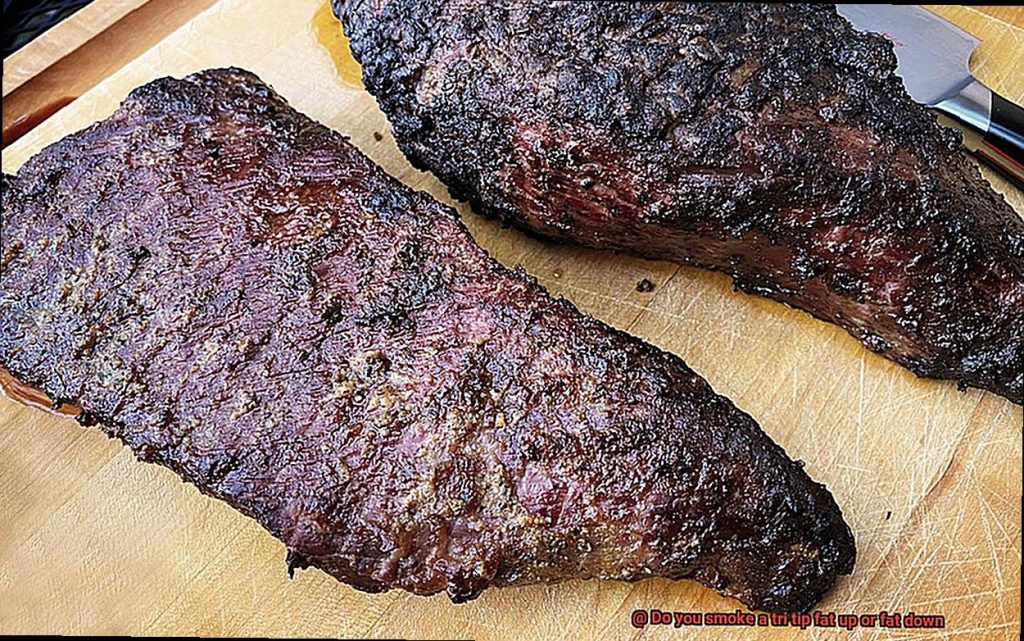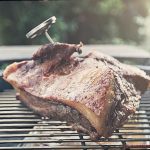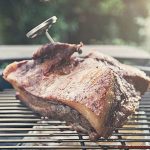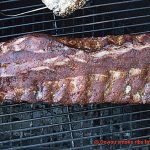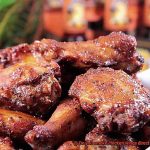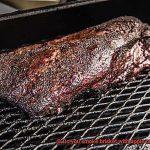The mere thought of sinking your teeth into that tender, juicy beef is enough to make any carnivore weak at the knees. But amidst the smoky haze and mouthwatering aromas, there’s one question that ignites fiery debates among grill masters: fat up or fat down?
It’s a dilemma that has sparked lively conversations around sizzling grills and heated online forums. In this blog post, we’ll dive into the arguments on both sides and aim to put this meaty dispute to rest once and for all.
So, grab your favorite cold beverage and prepare to embark on a flavorful journey through the world of tri tip smoking.
Contents
What is a Tri Tip?
Look no further than the tri tip, an incredibly flavorful and versatile cut of beef that is sure to amaze your loved ones.
In this comprehensive guide, we will delve into the world of tri tip, exploring its origins, cooking techniques, and settling the age-old debate of whether to smoke it fat side up or down.
So grab your apron and let’s embark on a journey of culinary excellence.
What is a Tri Tip?
The tri tip, also known as triangle roast or Santa Maria steak, is a triangular-shaped muscle nestled in the bottom sirloin region of the cow.
This succulent cut weighs approximately 2-3 pounds and possesses just the right amount of marbling, ensuring each bite is a juicy explosion of flavor.
With its remarkable versatility, the tri tip can be cooked whole, sliced into steaks, or incorporated into a myriad of delectable recipes.
Cooking the Tri Tip:
To truly savor the tenderness and juiciness of tri tip, it is best cooked to a medium-rare or medium doneness. Overcooking this delicacy can result in a disappointing dry and tough texture, so exercise caution and employ a trusty meat thermometer to monitor its internal temperature. Whether you opt for grilling or smoking, remember that slow cooking is essential in achieving that perfect pink center.
Fat Side Up or Down?
The grilling community has long been divided over the orientation of the tri tip during smoking: fat side up or down? Placing the fat side up allows the melting fat to baste the meat as it cooks, infusing each morsel with unparalleled juiciness and flavor.
Conversely, opting for fat side down ensures superior heat distribution, resulting in a more evenly cooked masterpiece. Furthermore, this method creates a tantalizingly seared crust on the bottom, adding another layer of texture and taste.
The Debate: Fat Up or Down?
Barbecue aficionados can’t seem to agree on the best method for smoking a succulent tri tip. Let’s delve into the pros and cons of each approach, as well as the option of trimming off the fat entirely.
Advocates of the fat up method argue that placing the tri tip with the fat side up allows the fat to slowly render down into the meat as it cooks.
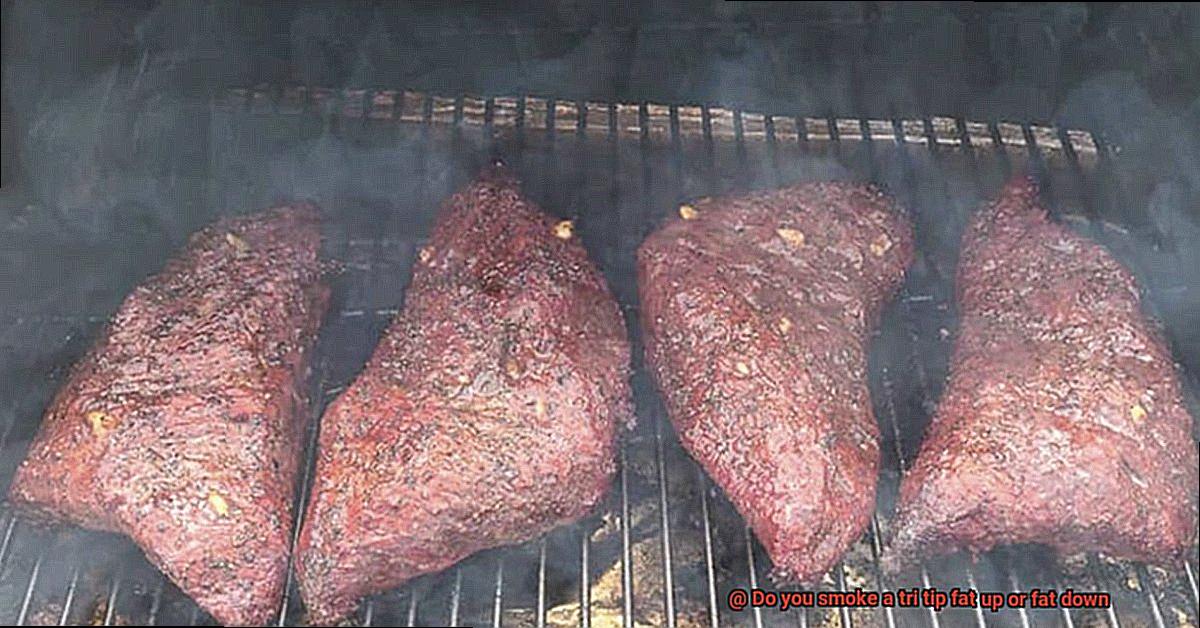
This results in a tantalizingly flavorful and moist final product.
The melted fat acts as an internal basting agent, ensuring each bite is juicy and tender.
On the flip side, supporters of the fat down technique believe that placing the tri tip with the fat side down creates a protective barrier.
This shield prevents the meat from drying out and promotes more even cooking. The fat acts as an insulator, preventing excessive charring and maintaining a succulent interior.
Now, let’s consider those who prefer to trim off the fat entirely. They contend that fat can impede smoke penetration and lead to an unpleasantly greasy texture. By removing the fat, they aim to achieve a cleaner and more pronounced smoky flavor.
So, which method reigns supreme? Ultimately, it boils down to personal preference and desired outcome. If you crave a melt-in-your-mouth experience bursting with rich flavors, smoking fat up is your ticket. If even cooking and protection against dryness are your top priorities, opt for fat down. And if you yearn for a pristine texture with a robust smoke essence, trim off the fat.
Remember, regardless of your chosen approach, monitor your tri tip’s internal temperature diligently to achieve your desired level of doneness. Additionally, allow it to rest after smoking to ensure optimal juiciness.
Pros and Cons of Placing the Fat Side Up
Let’s dive into the pros and cons of each method to help you make an informed decision that will leave your taste buds singing with delight.
Let’s start with the proponents of placing the fat side up. They argue that this method acts as a shield, protecting the meat from drying out during the smoking process. Picture this: a succulent and tender tri tip, its precious juices locked in by a layer of fat acting as a natural barrier. It’s like creating a fortress of flavor.
But that’s not all – placing the fat side up also allows the fat to slowly render down and baste the meat as it cooks. As the melting fat drips down onto the surface of your tri tip, it adds moisture and enhances the overall taste. It’s like nature’s own self-basting system, ensuring that every bite is juicy and mouthwatering.
And let’s not forget about that beautiful caramelized crust we all crave. As the fat renders down, it combines with your seasonings to form a delicious crust on top of your tri tip. The result? A symphony of flavors and textures dancing on your palate.
Now, let’s explore the other side of the debate – placing the fat side down. Advocates of this method argue that it allows for better heat distribution. With the fat side down, the heat can evenly penetrate through the meat, resulting in more consistent cooking and a more even doneness throughout. No one wants a tri tip that’s raw in one spot and overcooked in another.
Another advantage of placing the fat side down is that it creates a nice crust on the bottom surface of your tri tip. As the fat renders and drips down, it caramelizes and forms a flavorful crust that adds another layer of texture and taste to your final masterpiece. It’s like a secret surprise waiting to be discovered with every bite.
However, there are some potential downsides to placing the fat side up. One concern is that the fat may not fully render down during the smoking process, leaving a layer of unappealing chewy fat on top of your meat. That’s definitely not the texture or taste you’re looking for. It’s like biting into a disappointment instead of a culinary triumph.
Additionally, placing the fat side up can hinder smoke penetration into the meat. The layer of fat acts as a barrier, preventing the smoky flavors from fully infusing into your tri tip. If you’re all about that bold and robust smokiness, this might not be the method for you. It’s like missing out on a flavor adventure that could take your taste buds to new heights.
But wait, there’s another option. Some brave souls prefer to trim off that fatty layer altogether. They argue that it can hinder smoke penetration and leave behind an unpleasantly greasy texture. By bidding farewell to the fat, they strive for a cleaner and more pronounced smoky essence in their triumphant tri tips. It’s like stripping away the unnecessary to reveal the true essence of the meat.
In conclusion, there are pros and cons to placing the fat side up or down when smoking a tri tip. Placing the fat side up can help protect your meat from drying out, baste it with rendered fat, and create a caramelized crust on top.
However, it may hinder smoke penetration and result in chewy unrendered fat. On the other hand, placing the fat side down allows for better heat distribution and creates a crust on the bottom surface, but it may result in a milder smoke flavor.
And for those who desire a cleaner and more pronounced smoky essence, trimming off the fat is an option worth considering.
Pros and Cons of Placing the Fat Side Down
When it comes to grilling a tri tip, the debate of whether to place the fat side up or down is a hot topic among grill masters.
Each method has its own set of pros and cons, so let’s take a closer look at the advantages and potential drawbacks of placing the fat side down.
One of the main benefits of placing the fat side down is that it allows the fat to melt and render, creating a self-basting effect. As the fat drips down onto the meat, it adds moisture and flavor, resulting in a juicier and more flavorful final product. Additionally, having the fat side down can help protect the meat from direct heat, reducing the risk of overcooking or drying out.
Another advantage of placing the fat side down is that it helps to create a nice crust on the meat. The fat acts as a barrier between the meat and the heat source, allowing for a more even and consistent cooking process. This can result in a beautiful caramelized exterior that adds texture and flavor to the tri tip.
However, there are also some potential drawbacks to placing the fat side down. One concern is that it can prevent some of the smoke flavor from penetrating the meat. The fat acts as a barrier that can block some of the smoke particles from reaching the meat’s surface, potentially reducing the overall smoky flavor.
Additionally, placing the fat side down may not be suitable for all cooking methods or equipment. For example, if you are using a grill with direct heat, having the fat side down may cause flare-ups and excessive smoke due to the dripping fat. In such cases, it might be advisable to place the fat side up or use indirect heat cooking methods to minimize these issues.
Lastly, personal preference also plays a role in deciding whether to place the fat side up or down. Some people prefer a leaner and less fatty end result, while others enjoy the added moisture and richness that comes from cooking with the fat side down. It ultimately depends on your taste preferences and desired outcome.
Tips for Perfectly Smoked Tri Tip
When it comes to smoking tri tip, there’s an ongoing debate among grillers about whether to place the fat side up or down. Both methods have their benefits, and it ultimately comes down to personal preference. In this essay, we will explore the importance of using quality meat and outline the different methods for smoking tri tip to achieve the perfect end result.
The Importance of Quality Meat:
To ensure a delicious smoked tri tip, it is crucial to start with a well-marbled piece of meat. Look for tri tips with good fat distribution, as this will keep the meat moist and flavorful during the smoking process. Quality meat is the foundation of a perfect smoked tri tip.
Seasoning for Flavor:
Before smoking, season your tri tip with a dry rub or marinade of your choice. This will add flavor to the meat and create a delicious crust on the outside. Experiment with different seasonings to find your favorite combination and enhance the taste of your smoked tri tip.
Fat Side Up:
Placing the tri tip fat side up allows the fat to melt slowly, basting the meat and keeping it moist throughout the smoking process. The fat also acts as a natural barrier, preventing the meat from drying out and providing additional flavor. This method is favored by many pitmasters for its ability to produce juicy and tender smoked tri tip.
Fat Side Down:
Some pitmasters prefer to smoke the tri tip fat side down. They believe that this allows the fat to melt and penetrate into the meat, resulting in a more flavorful end product. This method can also help create a crispy exterior on the tri tip. It is important to note that this method may result in some loss of flavorful juices from the fat.
Monitoring Internal Temperature:
Regardless of which method you choose, monitoring the internal temperature is crucial for achieving perfect results. Aim for a final temperature of around 130-135°F for medium-rare or 140-145°F for medium doneness. Using a meat thermometer will ensure accurate temperature readings and prevent overcooking or undercooking your smoked tri tip.
How to Prepare a Tri Tip for Smoking
Smoking tri tip is a delicious way to enjoy the rich and tender flavors of this cut of beef. However, one question that often arises is whether to cook it fat side up or fat side down. In this comprehensive guide, we will explore both methods and help you make an informed decision based on your personal preferences.
Fat Side Up: The Juicy Baste Method
When smoking tri tip with the fat side up, you allow the fat to slowly melt and baste the meat as it cooks. This method creates a juicy and flavorful tri tip, as the fat acts as a natural barrier, keeping the meat moist throughout the smoking process. Additionally, cooking with the fat side up can result in a mouthwatering crust on top, adding an extra layer of flavor.
Fat Side Down: Even Cook and Perfect Crust
On the other hand, cooking tri tip with the fat side down allows for better heat distribution and an even cook. By placing the fat side down, the heat penetrates the meat more evenly, ensuring that it cooks at a consistent rate throughout. This method also helps develop a beautiful crust on the bottom of the tri tip. The fat acts as a protective layer, preventing direct contact with the heat source and allowing for a deliciously seared exterior.
Experiment and Find Your Perfect Method
The choice between cooking tri tip fat side up or fat side down ultimately comes down to personal preference and desired outcome. Some grill masters swear by one method, while others prefer to switch it up depending on the occasion. The best way to find your perfect method is through experimentation. Try smoking tri tip with both methods and see which one yields the juiciest and most flavorful results according to your taste preferences.
Different Smoking Methods for Tri Tip
If so, it’s time to explore the different smoking methods for tri tip. This delectable cut of meat can be transformed into a tender and flavorful masterpiece with the right technique. So grab your apron and let’s dive in.
First up, we have the traditional low and slow method. This tried and true technique involves cooking the tri tip at a low temperature for an extended period.
By maintaining a temperature around 225°F (107°C), the flavors develop slowly, resulting in a melt-in-your-mouth experience. With the fat side up, the meat is basted as it cooks, keeping it moist and juicy.
Next on our smoking journey is the reverse searing method. This technique starts with smoking the tri tip at a low temperature until it reaches the desired internal temperature. Then, crank up the heat and give it a quick sear over high heat. Slow smoking followed by intense searing creates a beautiful crust while maintaining that tender, smoky flavor. Some grill masters even start with the fat side up during smoking to render the fat and baste the meat before flipping it for a perfect sear.
Now, let’s talk about the “fat down” method. With this approach, keep the fat side down throughout cooking. The fat acts as a protective barrier between the meat and heat source, preventing it from drying out. As it renders slowly, it bastes the meat, resulting in a juicy and flavorful tri tip. This method is ideal for those who prefer a more tender and succulent final product.
Regardless of your chosen method, don’t forget to season your tri tip before smoking. Applying a dry rub or marinade of your choice enhances flavors and takes your smoked tri tip to new heights. Experiment with different wood chips or chunks to create unique flavor profiles.
Best Wood Chips to Use When Smoking a Tri Tip
Take your tri tip to the next level with the perfect choice of wood chips for smoking. The right wood chips can infuse your tri tip with a mouthwatering smoky flavor that will leave your taste buds begging for more.
In this article, we’ll explore the different types of wood chips available and their flavors that are most suitable for smoking a tri tip.
Mesquite Wood Chips:
Mesquite wood chips are a classic choice known for their strong and robust flavor. They pair perfectly with the rich and beefy taste of tri tip, adding a slightly sweet and smoky flavor. Mesquite is a favorite among pitmasters and is sure to impress your guests.
Hickory Wood Chips:
For a bold and distinct smoky flavor, hickory wood chips are the way to go. Hickory adds a rich and savory taste to the meat, enhancing the natural flavors of the tri tip. It’s no wonder why hickory is a favorite among many grill masters.
Apple Wood Chips:
If you prefer a milder flavor profile, apple wood chips are an excellent choice. These chips give the meat a subtly sweet and fruity aroma, adding a touch of complexity to the overall taste of the tri tip. Apple wood chips are perfect for those who enjoy a more delicate smoky flavor.
Cherry Wood Chips:
For a sweeter and more mild smoky flavor, cherry wood chips are the answer. These chips bring out the natural sweetness of the tri tip while imparting a beautiful reddish color to the meat when smoked. Cherry wood chips are sure to impress both your eyes and your taste buds.
Oak Wood Chips:
Craving an intense and bold flavor? Consider oak wood chips. Oak provides a strong and robust smokiness that can stand up to the rich flavors of the tri tip. These chips are perfect for those who want to take their smoked meat to the next level.
Soaking the Wood Chips:
Before using any wood chips, it’s important to soak them in water for at least 30 minutes. This prevents them from burning too quickly and allows for a steady release of smoke throughout the cooking process. Soaking the wood chips ensures that your tri tip will be infused with a consistent and delicious smoky flavor.
DFpJKwz3McE” >
Conclusion
When it comes to smoking a tri tip, the age-old debate of fat up or fat down has sparked countless discussions among grillmasters. While there is no definitive answer, it ultimately boils down to personal preference and desired outcome.
Some pitmasters swear by smoking the tri tip with the fat cap facing up. They argue that this allows the melting fat to baste the meat, keeping it moist and imparting a rich flavor. The fat acts as a protective barrier, preventing the meat from drying out during the cooking process. Plus, when cooked with the fat up, you get that beautiful caramelized crust on top.
On the other hand, there are those who advocate for smoking tri tip with the fat side down. They believe that this allows for better rendering of the fat, resulting in a more tender and juicy end product. By placing the fatty side directly on the heat source, they argue that it helps to melt away any excess fat and achieve a perfect balance of flavors.
Ultimately, whether you choose to smoke your tri tip with the fat up or down depends on your personal preference and desired outcome. It’s all about experimenting and finding what works best for you.

